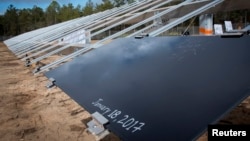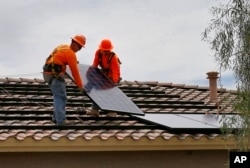New U.S. solar installations nearly doubled last year, but slowing demand for both residential and large-scale systems, falling panel prices and concerns about looming federal tax reform are still dampening investor appetite for the sector.
Solar installations soared 97 percent to 14.8 gigawatts in 2016, according to a report released Thursday by Wood Mackenzie and the Solar Energy Industries Association. The technology is cheaper than ever, with panel prices dropping 40 percent last year, and many utilities procuring solar on the basis of cost alone.
But the dramatic drop in panel prices has hampered solar manufacturers' profits and ramped up competition for utility-scale contracts among developers, companies said in recent weeks while reporting fourth-quarter results. Add in a slowdown in the residential market, tax reform pushed by U.S. President Donald Trump, climbing interest rates and falling oil prices, and stock market investors remain skittish about solar.
2017 a transition year
Credit Suisse analyst Andrew Hughes said in a client note on Thursday that the key risk to his "outperform" rating on shares of residential solar player Sunrun was "investor sentiment, which in a rising interest rate and falling oil price market obscured by tax policy uncertainty remains tepid."
The MAC Global Solar Energy index, which tracks shares of solar power companies, slid 43 percent in 2016. The index has recovered to gain nearly 8 percent so far this year but remains 65 percent below its year-ago level.
U.S. module manufacturers and project developers SunPower and First Solar Inc are both viewing 2017 as a transition year for their businesses, they said after reporting in February losses for the fourth quarter of last year.
SunPower Chief Executive Tom Werner in a conference call predicted "intense competition for the forseeable future in mainstream power plants," adding that some companies were selling panels at below cash cost.
A slowdown is forecast
Indeed, the solar industry report released Thursday forecasts a slowdown in the market this year after last year's boom. Utility systems accounted for more than 10.5 GW of the total in 2016, but are not expected to exceed 10 GW again until 2021, the report said.
The 2016 boom was largely due to a rush by developers to claim a federal tax credit for solar systems that had been expected to expire at the end of the year. The five-year extension of that credit, however, has allowed projects to be pushed into this year and beyond.
Though Trump has not called for ending tax credits for solar and other renewable energy, he has expressed doubts about the role of clean power sources.
Home installations are growing
On the solar residential side, installations grew 19 percent to 2.6 GW last year, down from 66 percent growth in 2015. Growth has slowed in major markets like California, where many of the households most interested in solar have already put up panels.
Tesla, which acquired residential market leader SolarCity late last year, said last month that it deployed 201 megawatts of solar in the fourth quarter, a more than 20 percent drop from the same period a year earlier.
SolarCity rival Sunrun reported a quarterly profit that topped Wall Street estimates due to cost cuts, but said growth would be substantially slower in 2016. System deployments rose 40 percent in 2016, but are expected to rise just 15 percent this year, Sunrun said.
"While it may be slowing, it is still growing. That is an important piece of the story," Abigail Ross Hopper, president of the Solar Energy Industries Association, said in an interview. "Some of that resetting is to be expected."










